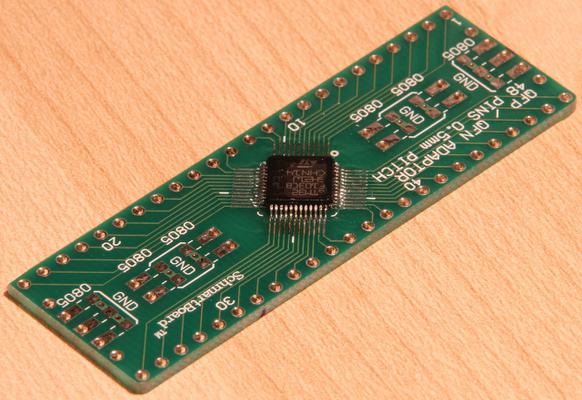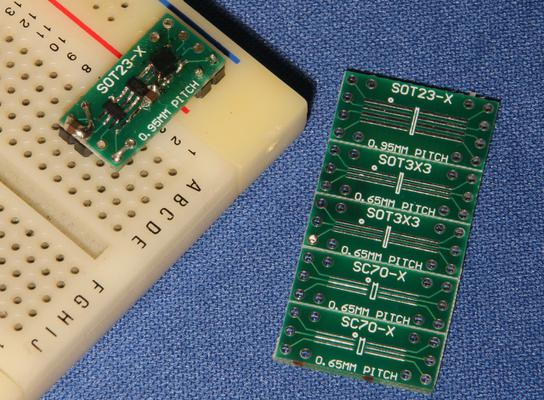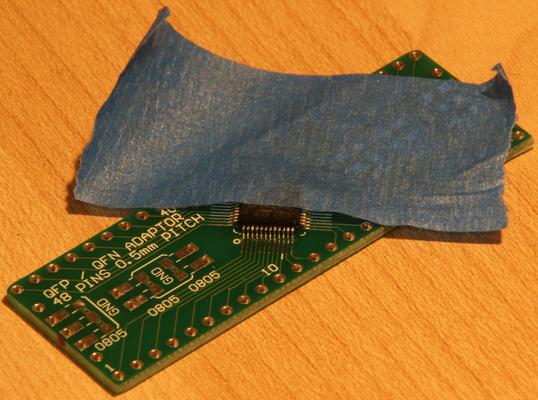Schmart Board Review
Last updated: June 10, 2012, 9:10 p.m.
There are lots of cases these days where the chip you want to play with are just not available in a through-hole variety. This is a real nuisance for hobbyists and even professionals who want to prototype a sub system before designing the PCB. You can get custom PCBs in small volumes very cheap these days but sometimes you lack the time or skills to make a custom PCB for simple jobs. There are a few suppliers of break out boards but they tend to be wildly over-priced cheap small PCBs with nothing remarkable in terms of features. SchmartBoard seems to be different, a few weeks ago I go sent a package of them for review and decided to look into what makes them special.
The main feature of the boards is the way they are made and pre-loaded with solder. The boards are made with recessed tracks which are filled with solder, this means you don't need to add solder (using little enough solder on SMD parts can be really hard) and also that the chip doesn't tend to misalign falling between the traces like a normal etched and heavily tinned PCB. The other nice thing about these boards is the thought that's gone into other features like decoupling cap footprints, the design of ground plane and the ability to flood thermal slugs through big plated through holes under the chips.
I've used a couple of the boards, one is a SOT23 break out which I managed to get a pair of SOT23 chips on because of their footprint, an MCP1603 regulator and the MCP102 micro-power voltage supervisor to shut it down under-voltage. This was handy and easy to use again it has a built in ground plane and full break out of the pins. It comes in a pack for a range of different SOT23 pitch and breakouts so it isn't too pricey as long as you need all the footprints. The different footprints are milled to an easy snap off v-groove style and you get 6 footprints for your $6. I think I'd probably prefer 6 of the same pitch footprint rather than the mixed batch here.
The other board I tried out was a 48 pin QFP/QFN to DIP breakout. I've soldered an STM32 ARM Cortex M3 microcontroller to this and I'm really looking forward to using it in some projects. This was much more challenging than the SOT23 chips which are pretty easy to solder. I have a rather nice Metcal PS-900 soldering iron with a 0.4mm long conical tip. For this a lead-free temperature iron is essential as the boards are pre-loaded with lead free solder. The fine tip and excellent temperature control with this iron help a lot. You also really need liquid flux for these parts. You may not have used a separate flux before because most solder wire is actually a hollow tube with flux filling it. This means the flux is applied to the work when you melt the solder wire, however in this case we're not using any solder wire, and the amount of solder melted wouldn't be enough to provide a sufficient dose of flux anyway. Flux is a kind of cleaner that stops the pins and board forming a coating you can't solder to. Be careful handling liquid flux and use fume extraction when soldering with it.
With the chip placed on the board I actually used some masking tape to hold the chip in place while I soldered the first side then took it off to solder the last three. It lined up pretty easily using a pair of tweezers and soldered down quickly. It only took me a few minutes to solder the whole 48pin part. I've taken some macro photos of the part and it looks like all the pins are connected with no shorts, but I haven't put it into a circuit to test it yet. Immediately afterwards I tried soldering an almost identical part onto a generic PCB and found it was more difficult and required a steadier hand. The tools I have are well up to the job though and I didn't have any mistakes or shorts on the standard PCB whether it would be so easy with cheaper tools I don't know.
At $6 a piece, for the boards I tried, these are only about a quarter of the price for a fully custom PCB from somewhere like iTead Studio (assuming you only need one board from the minimum batch of 10, if you need more than one a custom PCB is even cheaper). The custom PCB can save you a lot of time with wiring too and let you put a number of awkward connector and chip footprints together. Having said that, the SchmartBoard is quite a lot easier to solder than a 'standard' PCB and sometimes you just don't have time to draw up a custom board and get it made. Some products they do, like the BGA breakout boards offer opportunities not available through other methods for DIY electronics.
So if you want a breakout rather than designing your own PCB, SchmartBoard looks like a really good option. I've got more of their products to try including a huge break-out I'm really looking forward to trying when I have more time to put it into an actual project.
Comments
Posting comments is not currently possible. If you want to discuss this article you can reach me on twitter or via email.


